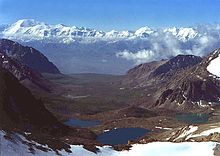Tajik National Park
| Tajik National Park | |
|---|---|
|
UNESCO world heritage |
|
| National territory: |
|
| Type: | nature |
| Criteria : | |
| Reference No .: | 1252 |
| UNESCO region : | Asia and Pacific |
| History of enrollment | |
| Enrollment: | 2013 (session 37) |
The Tajik National Park , also Pamir National Park , is a protected area in the Pamir Mountains in the eastern part of Tajikistan . It covers a total area of 26,000 km². The area was declared a national park by Tajikistan in 1992 and added to the list of UNESCO World Heritage Sites in 2013 .
geography
The park extends over areas of the West and East Pamirs and, with its 2.6 million hectares, makes up 11 percent of the national territory of Tajikistan. It is naturally heterogeneous and consists of different biomes such as alpine and high alpine mountain regions , grasslands , steppe and desert .
There are several protected areas in the park:
- Pamir reserve that the lake Karakul includes
- Zorkul reserve with the Zorkulsee system ( an important bird area according to the Ramsar list )
- Muskol reserve as a connection between the Transalai mountains and the Muskol chain
- Sanglyar Conservation Area, includes the Peter I chain
Flora and fauna

The vegetation and the resulting range of species of animals reflect the different habitats in this large protected area. Plants from both the Southwest and Central Asian floristic regions can be found in the Tajik National Park.
Nationally rare and endangered vertebrates and birds live in the region. The former include the Argali (in German also giant wild sheep ) (Ovis ammon group) and in the mountains the Irbis (Panthera uncia) and the Asiatic ibex ( Capra sibirica ) .
development
The area of the park was declared a national park in 1992 by the then barely one year old state of Tajikistan .
Starting in the mid-1990s, a Tajik-Swiss research project developed strategies in ten different sectors for a sustainable development of the park region in a ten-year project .
In 2013 the World Heritage Committee added the park to the list of UNESCO World Natural Heritage Sites .
protection
The Tajik National Park is one of the largest high mountain protected areas in the Palearctic . The Fedchenko Glacier is the largest still existing valley glacier in Eurasia . The area of the Tajik National Park belongs to the Tajik state and has been placed under the highest protection status in the country.
The World Heritage Committee emphasized the enormous size of the area with a mountainous-alpine desert landscape, far from human habitation, as characteristic. This leads to a high degree of physical integrity. The park's core zone makes up 78 percent, a percentage that is otherwise found in hardly any other world natural heritage area. For this reason, a compensation zone was dispensed with; instead, only three restricted use zones in the park's perepheria have been classified.
Web links
- Tajik National Park (Mountains of the Pamirs) on the IUCN "Protected Planet" page
- Tajik National Park (Mountains of the Pamirs) on the UNESCO site
literature
- Thomas Breu, Daniel Maselli, Hans Hurni: Knowledge for Sustainable Development in the Tajik Pamir Mountains. Mountain Research and Development, 2005. doi : 10.1659 / 0276-4741 (2005) 025 [0139: KFSDIT] 2.0.CO; 2
- O. Pereladova, V. Krever, M. Williams: Biodiversity Conservation in Central Asia. Moscow 1997, ISBN 5-7516-0137-8 .
- Algirdas Knystautas: The Natural History of the USSR. McGraw-Hill Book Company, New York 1987, ISBN 0-7126-1401-X .
Individual evidence
- ↑ Tajikistan sights: GORUMA. In: www.goruma.de. Retrieved November 16, 2016 .
- ↑ Pamir alpine desert and tundra | Ecoregions | WWF. In: World Wildlife Fund. Retrieved November 16, 2016 .
- ^ The Ramsar List of Wetlands of International Importance (PDF)
- ^ Thomas Breu, Daniel Maselli, Hans Hurni: Knowledge for Sustainable Development in the Tajik Pamir Mountains . In: Mountain Research and Development . tape 25 , no. 2 , May 1, 2005, ISSN 0276-4741 , p. 139-146 , doi : 10.1659 / 0276-4741 (2005) 025 [0139: KFSDIT] 2.0.CO; 2 .
- ↑ UNESCO World Heritage Center: Tajik National Park (Mountains of the Pamirs). In: whc.unesco.org. Retrieved November 17, 2016 .


